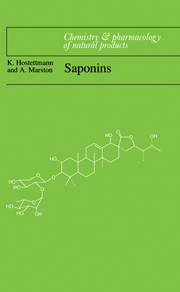Book contents
- Frontmatter
- Contents
- Glossary
- 1 Introduction
- 2 Occurrence and distribution
- 3 Analysis and isolation
- 4 Structure determination
- 5 Triterpene saponins – pharmacological and biological properties
- 6 Steroid saponins and steroid alkaloid saponins: pharmacological and biological properties
- 7 Commercially important preparations and products
- Appendices
- References
- Index of Latin names
- General index
6 - Steroid saponins and steroid alkaloid saponins: pharmacological and biological properties
Published online by Cambridge University Press: 19 October 2009
- Frontmatter
- Contents
- Glossary
- 1 Introduction
- 2 Occurrence and distribution
- 3 Analysis and isolation
- 4 Structure determination
- 5 Triterpene saponins – pharmacological and biological properties
- 6 Steroid saponins and steroid alkaloid saponins: pharmacological and biological properties
- 7 Commercially important preparations and products
- Appendices
- References
- Index of Latin names
- General index
Summary
A large number of steroid saponins and glycoalkaloids exhibit the foaming and haemolytic properties typical of saponins. They also share a large number of the biological activities of triterpene saponins, such as expectorant and diuretic effects. Furostanol glycosides are responsible for the bitter taste of asparagus (Kawano et al. 1975), tomato seed (Sato and Sakamura, 1973) and bittersweet (Solarium dulcamara, Solanaceae) (Willuhn and Köthe, 1983). Vernonioside A (869) from Vernonia amygdalina leaves (Asteraceae) is bitter at 7 µg in a paper disc sensory test – an activity similar to that of quinine sulphate (Ohigashi et al. 1991).
Some spirostanol saponins are formally bidesmosidic, i.e. they have two sugar chains. In the case of Convallaria species (Liliaceae), both chains are attached in the ring A and ring B regions, unlike the situation for most bidesmosidic saponins. Not surprisingly, therefore, they have the characteristic properties of monodesmosidic saponins rather than those of bidesmosidic saponins. On the contrary, the bidesmosidic furostanol saponins lack haemolytic activity, have no bacteriostatic and fungicidal effects and do not complex with cholesterol. Their only typical saponin property is the ability to foam when shaken in aqueous solution (Tschesche et al. 1969b). Bidesmosidic furostanol saponins are found mainly in the leaves and metabolically active organs; they can be considered as transport forms since plant wounding leads to their transformation into biologically active spirostanol glycosides. Monodesmosidic spirostanol saponins themselves are often found stored in the seeds and roots (Voigt and Hiller, 1987).
- Type
- Chapter
- Information
- Saponins , pp. 287 - 306Publisher: Cambridge University PressPrint publication year: 1995
- 2
- Cited by



